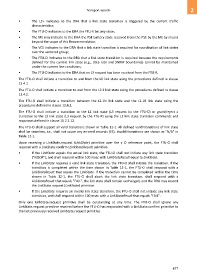Page 887 - 5G Basics - Core Network Aspects
P. 887
Transport aspects 2
• The L2+ indicates to the DRA that a link state transition is triggered by the current traffic
characteristics;
• The FTU-O indicates to the DRA the FTU-R battery state;
• The ME may indicate to the DRA the PSE battery state received from the PSE by the ME by means
beyond the scope of this Recommendation;
• The VCE indicates to the DRA that a link state transition is required for coordination of link states
over the vectored group;
• The FTU-O indicates to the DRA that a link state transition is required because the requirements
defined for the current link state (e.g., data rate and SNRM boundaries) cannot be maintained
under the current line conditions;
• The FTU-O indicates to the DRA that an L3 request has been received from the FTU-R.
The FTU-O shall initiate a transition to and from the L0 link state using the procedures defined in clause
13.4.1.
The FTU-O shall initiate a transition to and from the L2.2 link state using the procedures defined in clause
13.4.2.
The FTU-O shall initiate a transition between the L2.1N link state and the L2.1B link state using the
procedures defined in clause 13.4.3.
The FTU-O shall initiate a transition to the L3 link state (L3 request by the FTU-O) or grant/reject a
transition to the L3 link state (L3 request by the FTU-R) using the L3 link state transition commands and
responses defined in clause 11.2.2.12.
The FTU-O shall support all valid transitions shown in Table 12-1. All defined valid transitions of link state
shall be seamless, i.e., shall not cause any errored seconds (ES). Invalid transitions are shown as "N/A" in
Table 12-1.
Upon receiving a LinkState.request (LinkState) primitive over the γ_O reference point, the FTU-O shall
respond with a LinkState.confirm (LinkStateResult) primitive.
• If the LinkState equals the actual link state, the FTU-O shall not initiate any link state transition
("NOOP"), and shall respond within 100 msec with LinkStateResult equal to LinkState.
• If the LinkState requires a valid link state transition, the FTU-O shall initiate the transition. If the
transition is completed within the time shown in Table 12-1, the FTU-O shall respond with a
LinkStateResult that equals the LinkState. If the transition cannot be completed within the time
shown in Table 12-1, the FTU-O shall abort the link state transition, shall respond with a
LinkStateResult that equals "FAIL", the link state shall remain unchanged, and the DRA may resend
the LinkState.request (LinkState) primitive.
• If the LinkState requires an invalid link state transition, the FTU-O shall not initiate any link state
transition, and shall respond within 100 msec with a LinkStateResult that equals "FAIL".
Only one LinkState.request primitive shall be outstanding at any time. The FTU-O shall ignore any
LinkState.request primitive received before the FTU-O has responded with a LinkState.confirm primitive to
the last previously received LinkState.request primitive.
877

